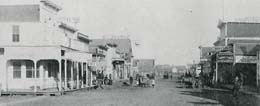On May 13, 1888, seven blocks of downtown Goldendale are destroyed by fire. The burned area encompasses most of the town's business district and some residential areas. Damage from the fire is estimated at $250,000. The Klickitat County Courthouse, built in 1879 by public donation without any county funds, is among the buildings destroyed. At the time of the fire, Goldendale has not a single building made of brick.
The fire started about 2:00 in the afternoon in James Dickson's livery stable. Because it was a Sunday, most businesses were closed and there were few people in the downtown area. Many of Goldendale's fewer than 1,000 townspeople had gone to a picnic at Three Creeks, northeast of town. Dickson, working in the office of the stable, heard a roaring noise that, upon investigation, proved to be a fire in his barn. Dickson nearly succeeded in putting out the blaze with a nearby bucket of water. But when he ran to refill the pail, the flames climbed to the roof of the barn, igniting the hayloft.
A Cry Of Fire!
The cry was sounded and Goldendale citizens began rushing to the vicinity of the blaze. It was evident to everyone that the barn was beyond help and that the fire was bound to spread. Goldendale had no water system at the time, only a series of wells, and the fire's intensity made it impossible for anyone to get near enough to fight the blaze with buckets of water.
A wooden cart with a hose attached was meant to serve as a sort of fire truck, but by the time the volunteer firefighters arrived, the cart was in flames. Residents rushed to save what they could from nearby buildings. In some instances possessions that had been carried out of buildings to supposed safety caught fire and burned in the street. People who lived outside of town and those attending the picnic saw the smoke and rushed to Goldendale with teams and wagons to help as save as many possessions as they could from the onrushing flames.
The fire destroyed The Goldendale Sentinel's publishing plant, but on May 17, 1888, a special edition of The Goldendale Sentinel was published in The Dalles by John Mitchell, publisher of another early paper, The Pioneer. The paper's report on the fire gave the women of Goldendale a nod of what was no doubt intended as unbounded approval:
"Women were screaming and children crying, but at the same time but few seemed to lose their entire presence of mind; on the contrary they worked nobly, giving evidence of possessing almost as much fortitude as the man (men) and an equal amount of judgment."
A Narrow Escape
In the midst of the chaos, Goldendale Sheriff William VanVactor remembered to rush to the small county jail next to the courthouse and free the single prisoner held within. Volunteer firemen, unable to force the lock, had hastily dismantled the jail's scaffold and were attempting to use it to batter down the door. The wooden jail was already in flames when the Sheriff VanVector arrived with its only set of keys.
When the smoke cleared, it was evident that the fire had consumed buildings in the area bordered by Broadway and Court streets and by Chatfield and Golden streets. In addition to businesses, 25 families lost their homes and all of their possessions, and the First Methodist Church was destroyed.
Losses were estimated at $250,000. Klickitat County's earliest public records, stored in the courthouse, were destroyed along with the building. The only buildings standing in Goldendale's central business district after the fire were a livery stable and a blacksmith shop.
Most of the buildings destroyed in the blaze were built between 1878, when Goldendale won the vote to be the seat of Klickitat County, and 1888.
Rising From Ashes
Townspeople pooled provisions and found shelter for those left homeless. Within three months some 20 structures had arisen from Goldendale's ashes, or were in the final stages of completion. Not surprisingly, many of these were made of brick. A second Klickitat County Courthouse was built, this time out of brick, in 1889. An Illustrated History of Klickitat, Yakima and Kittitas Counties, With An Outline Of The Early History of The State Of Washington, published in 1904, summed up the matter succinctly: "The people were made to realize the true economy of fireproof buildings, and out of the ruins rose a more substantial city than had ever before existed in the Klickitat Valley" (p. 133).
Amazingly, townspeople were able to accomplish this rapid rebuilding despite the fact that they had no railroad connection and therefore no ready way to access building materials from outside the immediate area. They used the abundant local timber, and local clay to make bricks.
On June 19, 1890, largely due to the role that the lack of water played in the fire's destructiveness, residents approved a bond issue to build a city water system fed by nearby streams. Only seven votes were cast against the measure.

